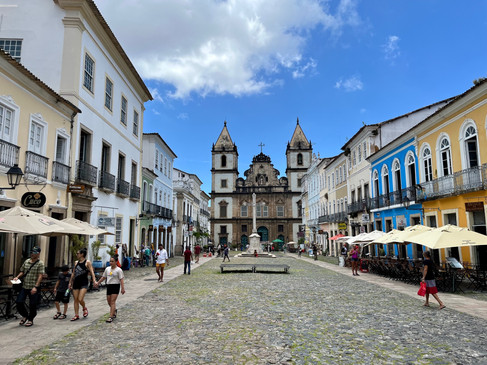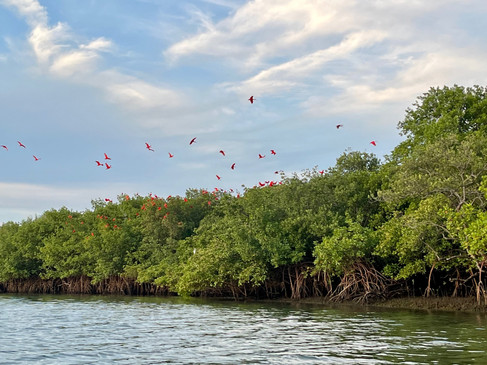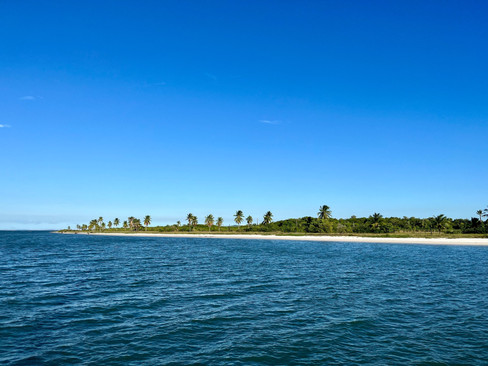Our first stay in the Baia de Todos os Santos was a short one.
On the day after our arrival, we attempted a repair of our autopilot (link) whilst at the anchorage by Bahia Marina.
As per the recommendation of our Brazilian friends, we moved to their Iate Clube (Marina) in the Bay of Aratu, a much smaller and protected bay within the Bay of Todos os Santos. The club would become too familiar due to our convoluted repair process.
On this first visit to the Bay of Todos os Santos, we took the opportunity to explore the old town of Salvador. It was just before Carnaval week and probably not the best time to see the city due to the festivities preparations.
We took an Uber from Aratu to the Capitania early morning to do yet one more piece of formalities and bureaucracy (link).
We were in absolute awe by the extent of the favelas (slums) as we saw them while driving on the highway.
São Salvador was the first capital of Brazil, dating back to when Brazil was one the most important Portuguese colonies. The city was also the first and biggest port for the arrival of the slaves coming from Africa. A horrible piece of history that still remains a huge legacy of the Portuguese occupation, that can very much be felt in this area not only in the form of the colonial architecture style in the old city centre but specifically in these favelas (slums) around the city.
The Bay of Todos os Santos was a great protected harbour for slave commerce but also a place that offered the opportunity for runaway slaves to hide. These favelas have, in my opinion, their origin in the Quilombos (jungle villages created by runaway slaves), which were once safe havens for these people taken from their homes on the other side of the ocean. In recent history, the Quilombos now favelas have become places of great poverty, insecurity and violence.
As you drive around this huge bay it is possible to understand how Quilombos could strive here, still today, the tropical jungle is so dense that cutting through it is nearly impossible. Before the invention of engines, most of this huge bay was very remote whilst so close. A guess of mine, the abolition of slavery in Brazil in 1888 was the point when all these Quilombos saw massive growth creating the path to what the favelas now are.

Criminality is apparently very high in this city, and locals seem to live in a state of permanent fear (that’s what we felt from conversations), everyone you as a foreigner and tourist talk to, will warn you lengthy of the dangers of the city. Don’t walk anywhere take an Uber, never wear any kind of jewellery, don’t show your phone, etc., it becomes to the point of being oppressive and a state of mind because as you walk the city locals do carry some jewellery, use their phones, and of course, walk around. The police presence in the historical town is absolutely brutal, with officers stationed nearly at every corner.
We took precautions when deciding to explore the streets of the old town only by daylight hours.
The old town is referred to by the name Pelourinho. You would have to be Portuguese and know a bit of history to understand how even the choice of using this word to refer to a part of town is part of the terrible legacy of this city. Pelourinho is usually a stone cross or column that was placed at the centre of any town, it marks its Christianity but also had an administrative role. It was where severe punishments were inflicted during several periods of history as the Inquisition and the slavery periods. A peculiar choice of name in today's age for the historical centre.
We visited pre-Carnaval when several buildings were boarded up to protect them from the expected carnaval excesses.
We visited the Capitania on the waterfront and then took the Elevador Lacerda that connects the city's two levels, allowing us a great view over the bay. Once at the top of the hill, we meandered for a couple of hours in the small streets.
The area has a very Portuguese flare but does not share the bright colour schemes used in Olinda.

Although still quite colourful the style is a bit more sober, the churches on the other hand are as ostensive as I expected. We didn’t get to visit their interiors because they were either boarded up or charging tickets at the entrance, something I find profoundly wrong unless it was converted into a museum experience (not the case).
With our small exploring experience of Salvador done, we moved back on anchor to a place on the opposite side of the bay called Itaparica, before heading further south to meet up with our sailing friends Rita and Rubens. We would visit Itaparica a few times during our stay in the Bay of Todos os Santos. The place is quite calm and low profile during weekdays with a bit more movement during the weekend.
The anchorage and navigation are a bit peculiar. The entrance to the anchorage is dotted with concrete structures related to the gas extraction (might be oil also) that seemed abandoned, there’s also a strange place where a ship can tie up in between two big concrete pontoon structures that we found out are used by the Brazilian Navy to demagnetise (?) submarines. Besides passing in between all these structures with care, it is necessary to pay attention to the sand bank that separates Itaparica from the river arm that connects the bay of Todos os Santos to the sea.
This sand bank protects the village and is part of the local economy. Tour boats come at low tide and nearly beach on the sand bar where they bring the tourists to party. It also provides the local fishermen with produce.
This makes the anchorage long and narrow, the top is occupied by local sailboats on moorings while the fishermen keep their pirogues on moorings by the beach. There’s also a newly built but abandoned marina with fishing boats where it is possible to moor for free or leave the dinghy, but theft on dinghies and cockpits is reported here often.
The village is very simple, mostly small vacation houses that are closed much of the time. The town square has a church and few eateries, but the life of the town is the beach and the sand bank.
The beach has a couple of eateries giving service of local Brazilian snacks, but the fun begins when the Vodka Icecream guy arrives.

He puts on a great show dancing while preparing his concoction of Picolé (ice cream on a stick) of local fruits flavours and a big dash of vodka, but for us, the highlight was the sandbar where we took Ella at low tide to play while we entertained ourselves catching some local clams called Chumbinhos.

Another place we enjoyed quite a bit during our second visit to the Bay of Todos os Santos was the two free mooring fields on the north side of Ilha dos Frades, each mooring field is on a different side of the smaller island Ilha de Bom Jesus.
The one that seems to be preferred by the local sailor's friends of ours is called Loretto (the name of the nearby village on the main island Ilha dos Frades), the other one is known as Suarez and is located on the other side of the island Ilha de Bom Jesus (its name derives from the private luxury resort that pays for the mooring field installation and maintenance - it is said the wife of the millionaire that owns the resort likes to see sailboats in front of their small island so they made this small mooring field free of charge to the exclusive use of sailboats).

I personally preferred the Suarez mooring field. Although the bay is much smaller and the moorings are quite close to each other, the view here is amazing. It’s not possible to see any of the cargo, tankers or refinery docks that seem to be everywhere in the bay of Todos os Santos, all you can see is the mangroves, the private resort that is quite discreet and low-key, the back of the fishermen village on the island of Bom Jesus and the big reason to visit this place: the exotic birds that frequent this bay but not the other anchorage just around the corner.
When our local sailor friends told us about this place we simply could not believe what they were saying, big Araras (Macaws) visit the boats on the mooring field looking for snacks and are quite friendly, resting on people’s heads, on the boats etc., and huge flocks of Guarás (Scarlet Ibis) can be seen feeding on the mud flats and retreating at night to a specific mangrove nearby to sleep at sundown.
We, of course, had to see it with our own eyes.
The navigation in, the first time is a bit confusing, the channel is quite narrow and shallow and once in it feels very small at first sight. The moorings feel very close to each other, but it seems it is just the result of having such a long line that gets buried in the mud giving that impression.
When we arrived just after Carnaval we first went to the Loreto mooring field. We had been coming ahead of a huge squall (in Brazil they call them Pirajás) as we navigated the buoyed channel that leads to the north side of Ilha dos Frades, as we reached the north of the island and passed the narrow channel right next to big refinery dock the squall was about to hit us, we had just enough time to enter the bay of the mooring field of Loreto and drop anchor right in the middle as the squall abated on us. It was lunchtime on a Sunday, and just after this squall hit us a few tour boats arrived making an unbelievable amount of noise that made us decide to lift anchor and move to the other mooring field (where they are not allowed because they are not sailboats) just to run away from the noise.
The moment we had finished tying up to a mooring ball on the Suarez mooring field two huge blue and gold Araras came to visit us.
One landed on the Bimini hardtop while the other landed on our Hydrovane (the wind vane part was off luckily).
They were just gorgeous!
Ella was lying down on the cockpit floor by the main helm station when she saw this beautiful bird. In her mind that must have been the most interesting chicken she had seen her entire life because she got up really fast and sat just by the Hydrovane looking at the Arara as if wondering what the colour blue tasted like.
The Arara looked at Ella with disdain and slowly took off.
They never returned to our boat, to much of my disappointment, they would fly around us often though.
It was quite incredible the presence of these wild birds considering the insane noise coming from the mooring field on the other side of the island that could still be heard here so loud and clear.
By late afternoon we finally spotted the Guarás returning to a specific mangrove area behind the fishermen's village on Ilha de Bom Jesus. Countless small flocks of these amazing bright red birds were coming from all directions to rest at this place forming a huge flock. The mangrove where they were landing to rest already had several White Ibis there.
Somehow between this vision and the stunning sunset, all that was coming to my mind was the Queen of Hearts playing cricket with Flamingos in Alice in Wonderland. Yes, my mind is strange.
For a few days, we stayed here marvelling at these birds, watching their comings and goings. Seeing them at low tide feeding on the mud flats.
We took the opportunity to come closer to them by letting the dinghy drift in the wind in their direction or by paddling slowly in their direction. The best time was when we took the dinghy just before their return to the mangrove at sundown, dropped an anchor and stayed very quietly in the dinghy enjoying their dance in the skies as each chose which mangrove branch to land on. A fun show that only got better when two of the big blue Araras from the resort decided to do a fly-by at a low height just above the dinghy (nearly crashing into our heads) only to go scare all the Guarás and White Ibis that had already settled for the end of the day in the mangrove. As the Araras wreaked havoc on the mangrove all the Guarás took off scared at the same time dotting the entire sky with red. Oh, what a show!
The Araras were clearly happy with their efforts as they too returned to the resort in the last minutes before sunset. Their sound was as if laughing loud mayhem complete.
Besides these places already mentioned, we also visited Salinas da Margarida before we decided we had tested the autopilot enough and was time to start our journey north.
The village of Salinas da Margarida is one of those places that only have a life during the summer season, so when we visited it felt like an abandoned place without anyone but we spent an afternoon with our Brazilian sailor friends by a shallow area just before the salt flats that turned out to be a great afternoon just chilling, at least until the mosquitoes attack!
That’s one thing that seemed to be very common across all of the anchorages in the Bay of Todos os Santos, the number of mosquitoes every night but also during the day sometimes, I guess being such a wet place it is expected but we seem not have been able to deal with it very successfully given the amount of bites we constantly suffered despite mosquito coils, repellent and mosquito nets.
We thought the Bay of Todos os Santos would be a great place to just have some fun sailing but we seemed to bit by violent squalls just about every time we went sailing. We became quite good at calculating when was it the last minute to pack the sails before the punch.

A thing that was quite shocking to us was just the sheer amount of oil and gas refineries and docks we could see all over the bay, including a pontoon built in the middle of the bay. The constant cargo and pilot boats traffic crisscrossing the bay. The flaring of these toxic fossil fuels at these refineries is simply terrifying considering how close it is to this big metropolitan area, visible day and night.
It was quite surprising that we managed to see dolphins almost every time we went out sailing, especially if close to Itaparica. This pod of very small and shy dolphins lives on this bay despite all this! Just like it was so surprising to see the Guarás (Scarlet Ibis) and Araras (Macaws) living right next to a huge and busy refinery. Knowing that the bay is visited by humpback whales around August makes it even more mind-blowing.
The Bay of Todos os Santos, all these spots that seemed to have stopped in time, the city of Salvador and the wildlife that can be seen here truly are something to make you awe!
***More photos of this place can be seen on Sailing The Dream facebook page just click on the album: Brazil - Salvador da Bahia/Baia de Todos Santos - February 2023
***In the spirit of sharing our dreams and experiences we have shared this blog post in the NOFOREIGNLAND.COM website sailors community.














































































Comments